AI In Renewable Energy Market Size 2025-2029
The ai in renewable energy market size is valued to increase by USD 14.44 billion, at a CAGR of 31.8% from 2024 to 2029. Increasing penetration and inherent intermittency of renewable energy sources will drive the ai in renewable energy market.
Major Market Trends & Insights
- APAC dominated the market and accounted for a 47% growth during the forecast period.
- By Deployment - Cloud-based segment was valued at USD 1.07 billion in 2023
- By Application - Forecasting segment accounted for the largest market revenue share in 2023
Market Size & Forecast
- Market Opportunities: USD 1.00 million
- Market Future Opportunities: USD 14438.00 million
- CAGR from 2024 to 2029 : 31.8%
Market Summary
- In the renewable energy sector, Artificial Intelligence (AI) is increasingly becoming an indispensable tool for optimizing energy production and management. This expansion is driven by the increasing penetration and inherent intermittency of renewable energy sources, necessitating advanced predictive analytics and automation to ensure grid stability and efficiency. AI-powered digital twins are a prime example of this technological evolution. These virtual replicas of physical assets enable real-time monitoring, predictive maintenance, and performance optimization.
- However, challenges persist. Data quality, accessibility, and standardization issues hinder the seamless integration and effective utilization of AI in renewable energy systems. Despite these hurdles, the future of AI in renewable energy is promising, with innovations in machine learning, edge computing, and advanced analytics poised to revolutionize the sector. By enhancing operational efficiency, reducing costs, and improving sustainability, AI is set to play a pivotal role in the transition to a low-carbon future.
What will be the Size of the AI In Renewable Energy Market during the forecast period?
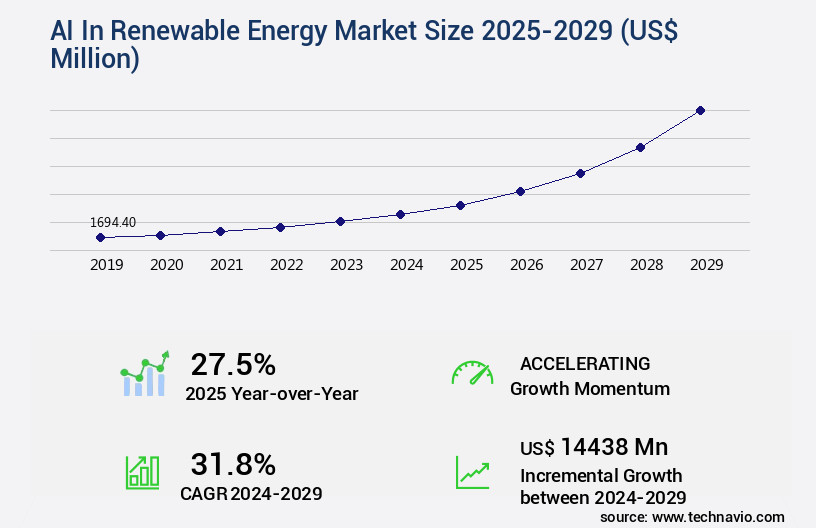
Get Key Insights on Market Forecast (PDF) Request Free Sample
How is the AI In Renewable Energy Market Segmented ?
The ai in renewable energy industry research report provides comprehensive data (region-wise segment analysis), with forecasts and estimates in "USD million" for the period 2025-2029, as well as historical data from 2019-2023 for the following segments.
- Deployment
- Application
- Forecasting
- Renewables management
- Safety and security
- Infrastructure
- Robotics
- End-user
- Energy generation
- Utilities
- Energy transmission
- Energy distribution
- Geography
- North America
- Europe
- APAC
- Australia
- China
- India
- Japan
- South America
- Rest of World (ROW)
By Deployment Insights
The cloud-based segment is estimated to witness significant growth during the forecast period.
In the evolving landscape of the market, cloud-based solutions have emerged as the fastest-growing segment. Renowned cloud providers, including Amazon Web Services, Microsoft Azure, and Google Cloud, offer infrastructure, platforms, and software services that cater to renewable energy operators managing dispersed wind, solar, and storage assets. The cloud's advantages—scalability, cost efficiency, and access to advanced computational resources—are particularly valuable for processing massive data volumes essential for applications like long-term weather and generation forecasting, fleet-wide asset performance management, and energy trading optimization. Machine learning models, such as deep learning and natural language processing, are trained on this data to optimize wind turbine performance, improve solar energy prediction, and enhance energy efficiency.
Furthermore, AI applications like demand-side management, grid modernization, renewable energy integration, cybersecurity for grids, energy consumption modeling, and solar panel efficiency assessment are facilitated by these cloud-based platforms. According to recent estimates, The market is projected to grow at a compound annual growth rate of 20.4% between 2021 and 2028.
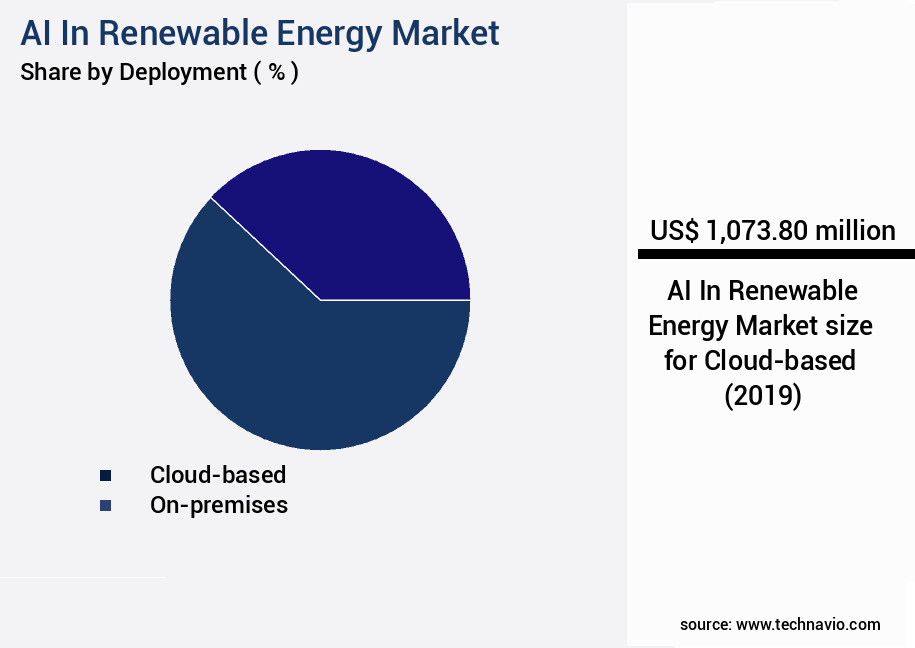
Request Free Sample
The Cloud-based segment was valued at USD 1.07 billion in 2019 and showed a gradual increase during the forecast period.
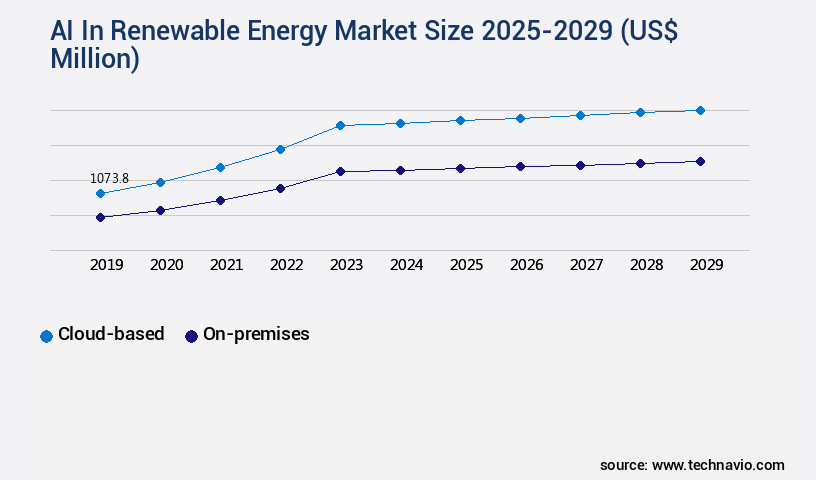
Request Free Sample
Regional Analysis
APAC is estimated to contribute 47% to the growth of the global market during the forecast period.Technavio's analysts have elaborately explained the regional trends and drivers that shape the market during the forecast period.
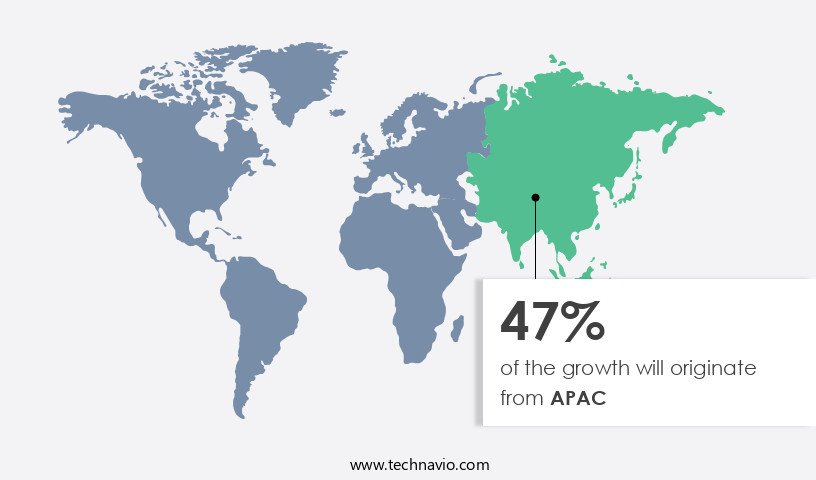
See How AI In Renewable Energy Market Demand is Rising in APAC Request Free Sample
The market is experiencing significant evolution, with the Asia-Pacific region leading the charge due to its vast scale of new capacity additions and diverse economic landscapes. Countries like China and India, driven by the pressing needs to meet escalating energy demand, combat severe air pollution, and bolster energy security, are at the forefront of solar and wind power deployment. The sheer size of these installations necessitates AI for centralized monitoring, control, and forecasting to ensure grid stability. In technologically advanced nations such as Japan, South Korea, and Singapore, the focus shifts to managing complex urban energy systems, integrating rooftop solar, and developing smart grid solutions in land-constrained environments.
These applications of AI contribute to enhancing renewable energy efficiency, reliability, and sustainability.
Market Dynamics
Our researchers analyzed the data with 2024 as the base year, along with the key drivers, trends, and challenges. A holistic analysis of drivers will help companies refine their marketing strategies to gain a competitive advantage.
The market is experiencing significant growth as artificial intelligence (AI) technologies, such as deep learning and machine learning, are being integrated into various applications to optimize renewable energy production and distribution. One key area of application is wind energy forecasting, where deep learning models are used to analyze historical data and real-time meteorological information to predict wind patterns and improve the accuracy of wind energy production forecasts. In the solar power sector, AI optimization is being used to maximize the efficiency of solar power plants by analyzing sensor data and adjusting energy production in real-time. Machine learning models are also being employed for smart grid management, enabling predictive maintenance and anomaly detection in power systems to ensure reliable and efficient energy distribution. AI-driven energy trading strategies are another area of focus, using real-time data analytics to optimize energy sales and purchases based on market conditions and renewable energy production. Renewable energy integration challenges, such as intermittency and variability, are being addressed through optimization algorithms for energy storage and carbon emission reduction strategies. Environmental impact assessment is another application of AI in renewable energy, using geospatial analysis and AI-powered fault detection to identify potential environmental risks and minimize their impact. Renewable energy resource mapping using GIS and improved solar panel efficiency through AI are also key areas of research and development. Optimal wind farm layout design and AI-based power generation scheduling are also being explored to ensure the efficient and effective integration of renewable energy into the power grid. Simulation models for grid modernization and data-driven decision support systems are essential tools for optimizing renewable energy production and distribution, reducing carbon emissions, and improving energy efficiency.
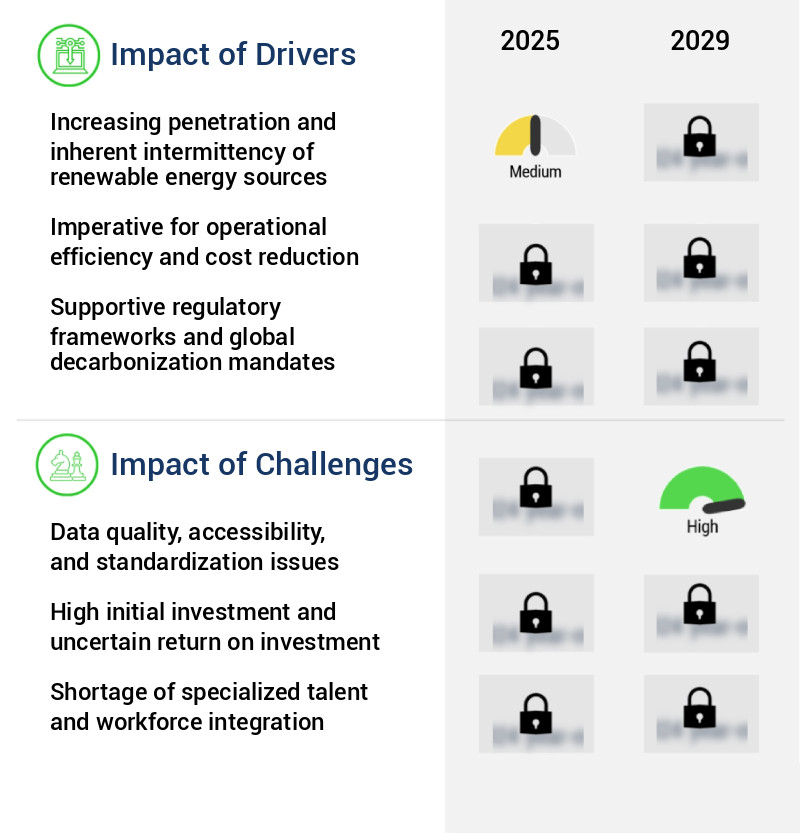
What are the key market drivers leading to the rise in the adoption of AI In Renewable Energy Industry?
- The increasing penetration and intermittency of renewable energy sources serve as the primary market drivers, necessitating advancements in technology and infrastructure to ensure reliability and efficiency in energy production and distribution.
- The integration of renewable energy sources, particularly solar and wind, into power grids presents complex challenges due to their inherent intermittency. Renewable energy's share in the global energy mix is increasing, making the need for advanced solutions to manage the variability of these sources more pressing. Traditional power plants offer consistent, dispatchable power, but renewable energy's output is dependent on meteorological conditions. This variability can lead to voltage and frequency deviations, potentially causing power quality issues or, in extreme cases, grid-wide blackouts.
- Artificial Intelligence (AI) is emerging as a critical solution to address these challenges. According to recent studies, The market is projected to reach a significant market size by 2026, growing at a substantial rate. AI's ability to predict and respond to renewable energy fluctuations in real-time enables grid operators to maintain the delicate balance between electricity supply and demand, ensuring grid stability.
What are the market trends shaping the AI In Renewable Energy Industry?
- The use of AI-powered digital twins is becoming increasingly prevalent for effective asset lifecycle management. This trend signifies a significant shift in the market towards advanced technology solutions.
- The integration of artificial intelligence (AI) in the renewable energy sector is revolutionizing the industry by introducing advanced digital twin technology. A digital twin is a high-fidelity, dynamic virtual representation of a renewable energy asset, such as a wind farm or a solar facility. This technology goes beyond static 3D modeling; it is an active, intelligent platform that assimilates real-time operational data from Internet of Things (IoT) sensors, historical performance logs, maintenance records, and meteorological data. AI-powered digital twins serve as transformative tools for lifecycle management, surpassing the capabilities of passive monitoring systems.
- According to recent studies, the global renewable energy digital twin market is projected to grow significantly, with AI adoption driving the expansion. For instance, AI integration can optimize energy production by predicting maintenance needs, enhancing performance, and minimizing downtime. This innovative technology's potential is vast, making it a game-changer in the renewable energy landscape.
What challenges does the AI In Renewable Energy Industry face during its growth?
- The growth of the industry is significantly hindered by challenges related to data quality, accessibility, and standardization. These issues, which include ensuring data accuracy, making data easily accessible, and implementing consistent data formats, require careful attention and resolution to promote industry progression.
- The integration of artificial intelligence (AI) in the renewable energy sector is a developing trend, with numerous applications spanning various sectors. AI's role in renewable energy is crucial due to the vast amounts of data generated from multiple sources, including Supervisory Control and Data Acquisition (SCADA) systems, meteorological stations, individual sensors on turbines and inverters, market pricing feeds, and grid condition monitors. Ensuring data integrity and accessibility is a persistent challenge. The renewable energy industry produces an enormous volume of data, with wind energy generating approximately 1.5 exabytes per year, and solar energy generating around 1 exabyte annually.
- AI models' effectiveness hinges on the quality, consistency, and volume of data used for training. As a professional, knowledgeable, and formal virtual assistant, it is essential to maintain a professional tone when discussing the integration of AI in the renewable energy sector.
Exclusive Technavio Analysis on Customer Landscape
The ai in renewable energy market forecasting report includes the adoption lifecycle of the market, covering from the innovator's stage to the laggard's stage. It focuses on adoption rates in different regions based on penetration. Furthermore, the ai in renewable energy market report also includes key purchase criteria and drivers of price sensitivity to help companies evaluate and develop their market growth analysis strategies.
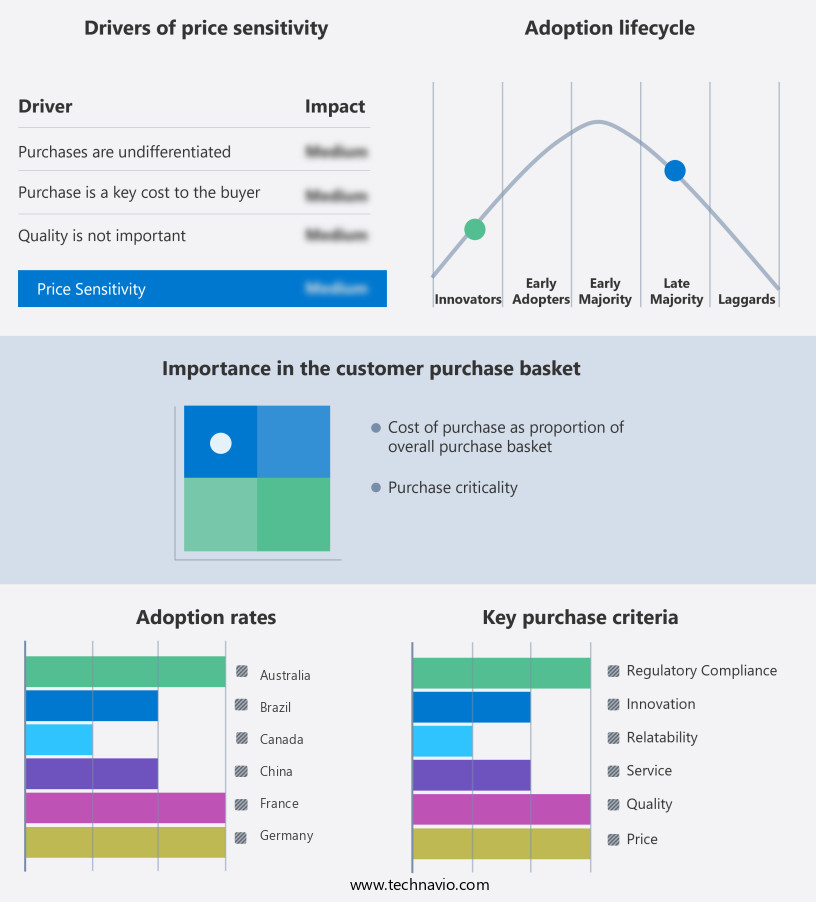
Customer Landscape of AI In Renewable Energy Industry
Competitive Landscape
Companies are implementing various strategies, such as strategic alliances, ai in renewable energy market forecast, partnerships, mergers and acquisitions, geographical expansion, and product/service launches, to enhance their presence in the industry.
Alpiq Holding AG - This company specializes in advanced AI technology for optimizing renewable energy management, encompassing direct marketing, forecasting, and flexible asset optimization. By leveraging artificial intelligence, energy companies can enhance operational efficiency and effectiveness.
The industry research and growth report includes detailed analyses of the competitive landscape of the market and information about key companies, including:
- Alpiq Holding AG
- AMP.ENERGY
- App Orchid
- Atos SE
- AutoGrid Systems Inc.
- BIDGELY INC.
- Enel X Italia S.r.l.
- Flex Ltd.
- Fluence Energy LLC
- General Electric Co.
- Next Kraftwerke GmbH
- Siemens AG
- SparkCognition Inc.
- Stem Inc.
- Tibber
- Uptake Technologies Inc.
- Veritone Inc.
Qualitative and quantitative analysis of companies has been conducted to help clients understand the wider business environment as well as the strengths and weaknesses of key industry players. Data is qualitatively analyzed to categorize companies as pure play, category-focused, industry-focused, and diversified; it is quantitatively analyzed to categorize companies as dominant, leading, strong, tentative, and weak.
Recent Development and News in AI In Renewable Energy Market
- In January 2024, Siemens Gamesa Renewable Energy and Microsoft announced a strategic collaboration to integrate Microsoft's Azure AI and IoT technologies into Siemens Gamesa's wind turbines, aiming to optimize energy production and maintenance (Microsoft Press Release).
- In March 2024, Vestas Wind Systems, the world's leading wind turbine manufacturer, raised €1.2 billion in a bond issuance to fund research and development in AI and digitalization, positioning itself as a key player in the market (Bloomberg).
- In May 2024, Enel Green Power, the Italian renewable energy company, received regulatory approval to build a 100 MW solar farm in Chile, which will be managed using AI and IoT technologies for optimization and maintenance (Enel Green Power Press Release).
- In April 2025, General Electric (GE) and LM Wind Power, a GE Renewable Energy business, entered into a partnership with IBM to apply IBM's AI and IoT solutions to GE's wind turbines, aiming to improve efficiency and reduce downtime (IBM Press Release).
Dive into Technavio's robust research methodology, blending expert interviews, extensive data synthesis, and validated models for unparalleled AI In Renewable Energy Market insights. See full methodology.
|
Market Scope
|
|
Report Coverage
|
Details
|
|
Page number
|
239
|
|
Base year
|
2024
|
|
Historic period
|
2019-2023 |
|
Forecast period
|
2025-2029
|
|
Growth momentum & CAGR
|
Accelerate at a CAGR of 31.8%
|
|
Market growth 2025-2029
|
USD 14438 million
|
|
Market structure
|
Fragmented
|
|
YoY growth 2024-2025(%)
|
27.5
|
|
Key countries
|
US, China, Germany, India, Japan, UK, Australia, Canada, Brazil, and France
|
|
Competitive landscape
|
Leading Companies, Market Positioning of Companies, Competitive Strategies, and Industry Risks
|
Request Free Sample
Research Analyst Overview
- The renewable energy market continues to evolve, driven by advancements in technology and the increasing demand for sustainable energy solutions. One of the key areas of innovation is the application of artificial intelligence (AI) and machine learning algorithms in various sectors. For instance, pattern recognition techniques are being used to optimize wind turbine performance by analyzing weather patterns and adjusting blade angles accordingly. This approach has led to a significant increase in energy efficiency, with some wind farms reporting up to 15% improvement in output. Moreover, AI is playing a crucial role in demand-side management and energy consumption modeling.
- By analyzing historical data and predicting future energy usage patterns, utilities can optimize energy production and distribution, reducing wastage and improving grid stability. For example, a utility company in Europe used a data analytics platform to analyze consumer behavior and adjust power generation accordingly, resulting in a 10% reduction in peak demand and a 5% decrease in overall energy consumption. The integration of renewable energy sources into the grid is another area where AI is making a significant impact. Grid modernization AI is being used to manage energy storage, diagnose faults, and optimize power flow. Anomaly detection systems are also being employed to identify and respond to cybersecurity threats, ensuring the security and reliability of the grid.
- Furthermore, AI is being used to predict solar energy production and improve solar panel efficiency. Machine learning algorithms are being used to analyze geospatial data and optimize the placement of solar panels based on local weather patterns and other environmental factors. Deep learning models are also being used to analyze satellite imagery and assess the environmental impact of renewable energy projects. The renewable energy market is expected to grow at a robust pace in the coming years, with industry experts projecting a growth rate of over 10% annually. The integration of AI and other advanced technologies is set to drive this growth, as the industry continues to innovate and adapt to the evolving energy landscape.
What are the Key Data Covered in this AI In Renewable Energy Market Research and Growth Report?
-
What is the expected growth of the AI In Renewable Energy Market between 2025 and 2029?
-
What segmentation does the market report cover?
-
The report is segmented by Deployment (Cloud-based and On-premises), Application (Forecasting, Renewables management, Safety and security, Infrastructure, and Robotics), End-user (Energy generation, Utilities, Energy transmission, and Energy distribution), and Geography (APAC, North America, Europe, South America, and Middle East and Africa)
-
Which regions are analyzed in the report?
-
APAC, North America, Europe, South America, and Middle East and Africa
-
What are the key growth drivers and market challenges?
-
Increasing penetration and inherent intermittency of renewable energy sources, Data quality, accessibility, and standardization issues
-
Who are the major players in the AI In Renewable Energy Market?
-
Alpiq Holding AG, AMP.ENERGY, App Orchid, Atos SE, AutoGrid Systems Inc., BIDGELY INC., Enel X Italia S.r.l., Flex Ltd., Fluence Energy LLC, General Electric Co., Next Kraftwerke GmbH, Siemens AG, SparkCognition Inc., Stem Inc., Tibber, Uptake Technologies Inc., and Veritone Inc.
Market Research Insights
- The market for AI in renewable energy is a dynamic and ever-evolving landscape. Two significant data points illustrate its growth and impact. First, the adoption of AI in wind energy has led to a 10% increase in energy production efficiency. For instance, advanced algorithms have been implemented to optimize wind turbine performance based on real-time weather data. Second, the renewable energy industry anticipates a 25% compound annual growth rate in AI investments over the next decade. This trend is driven by the need for improved operational efficiency, grid resilience, and cost reduction strategies.
- AI technologies, such as machine learning, simulation software tools, and optimization algorithms, are essential for power generation scheduling, control system design, and energy market simulation. These advancements contribute to the ongoing sustainability initiatives in the energy sector.
We can help! Our analysts can customize this ai in renewable energy market research report to meet your requirements.
Get in touch
1 Executive Summary
- 1.1 Market overview
- Executive Summary - Chart on Market Overview
- Executive Summary - Data Table on Market Overview
- Executive Summary - Chart on Global Market Characteristics
- Executive Summary - Chart on Market by Geography
- Executive Summary - Chart on Market Segmentation by Deployment
- Executive Summary - Chart on Market Segmentation by Application
- Executive Summary - Chart on Market Segmentation by End-user
- Executive Summary - Chart on Incremental Growth
- Executive Summary - Data Table on Incremental Growth
- Executive Summary - Chart on Company Market Positioning
2 Technavio Analysis
- 2.1 Analysis of price sensitivity, lifecycle, customer purchase basket, adoption rates, and purchase criteria
- Analysis of price sensitivity, lifecycle, customer purchase basket, adoption rates, and purchase criteria
- 2.2 Criticality of inputs and Factors of differentiation
- Overview on criticality of inputs and factors of differentiation
- 2.3 Factors of disruption
- Overview on factors of disruption
- 2.4 Impact of drivers and challenges
- Impact of drivers and challenges in 2024 and 2029
3 Market Landscape
- 3.1 Market ecosystem
- Parent Market
- Data Table on - Parent Market
- 3.2 Market characteristics
- Market characteristics analysis
4 Market Sizing
- 4.1 Market definition
- Offerings of companies included in the market definition
- 4.2 Market segment analysis
- 4.4 Market outlook: Forecast for 2024-2029
- Chart on Global - Market size and forecast 2024-2029 ($ million)
- Data Table on Global - Market size and forecast 2024-2029 ($ million)
- Chart on Global Market: Year-over-year growth 2024-2029 (%)
- Data Table on Global Market: Year-over-year growth 2024-2029 (%)
5 Historic Market Size
- 5.1 Global AI In Renewable Energy Market 2019 - 2023
- Historic Market Size - Data Table on Global AI In Renewable Energy Market 2019 - 2023 ($ million)
- 5.2 Deployment segment analysis 2019 - 2023
- Historic Market Size - Deployment Segment 2019 - 2023 ($ million)
- 5.3 Application segment analysis 2019 - 2023
- Historic Market Size - Application Segment 2019 - 2023 ($ million)
- 5.4 End-user segment analysis 2019 - 2023
- Historic Market Size - End-user Segment 2019 - 2023 ($ million)
- 5.5 Geography segment analysis 2019 - 2023
- Historic Market Size - Geography Segment 2019 - 2023 ($ million)
- 5.6 Country segment analysis 2019 - 2023
- Historic Market Size - Country Segment 2019 - 2023 ($ million)
6 Five Forces Analysis
- 6.1 Five forces summary
- Five forces analysis - Comparison between 2024 and 2029
- 6.2 Bargaining power of buyers
- Bargaining power of buyers - Impact of key factors 2024 and 2029
- 6.3 Bargaining power of suppliers
- Bargaining power of suppliers - Impact of key factors in 2024 and 2029
- 6.4 Threat of new entrants
- Threat of new entrants - Impact of key factors in 2024 and 2029
- 6.5 Threat of substitutes
- Threat of substitutes - Impact of key factors in 2024 and 2029
- 6.6 Threat of rivalry
- Threat of rivalry - Impact of key factors in 2024 and 2029
- 6.7 Market condition
- Chart on Market condition - Five forces 2024 and 2029
7 Market Segmentation by Deployment
- 7.1 Market segments
- Chart on Deployment - Market share 2024-2029 (%)
- Data Table on Deployment - Market share 2024-2029 (%)
- 7.2 Comparison by Deployment
- Chart on Comparison by Deployment
- Data Table on Comparison by Deployment
- 7.3 Cloud-based - Market size and forecast 2024-2029
- Chart on Cloud-based - Market size and forecast 2024-2029 ($ million)
- Data Table on Cloud-based - Market size and forecast 2024-2029 ($ million)
- Chart on Cloud-based - Year-over-year growth 2024-2029 (%)
- Data Table on Cloud-based - Year-over-year growth 2024-2029 (%)
- 7.4 On-premises - Market size and forecast 2024-2029
- Chart on On-premises - Market size and forecast 2024-2029 ($ million)
- Data Table on On-premises - Market size and forecast 2024-2029 ($ million)
- Chart on On-premises - Year-over-year growth 2024-2029 (%)
- Data Table on On-premises - Year-over-year growth 2024-2029 (%)
- 7.5 Market opportunity by Deployment
- Market opportunity by Deployment ($ million)
- Data Table on Market opportunity by Deployment ($ million)
8 Market Segmentation by Application
- 8.1 Market segments
- Chart on Application - Market share 2024-2029 (%)
- Data Table on Application - Market share 2024-2029 (%)
- 8.2 Comparison by Application
- Chart on Comparison by Application
- Data Table on Comparison by Application
- 8.3 Forecasting - Market size and forecast 2024-2029
- Chart on Forecasting - Market size and forecast 2024-2029 ($ million)
- Data Table on Forecasting - Market size and forecast 2024-2029 ($ million)
- Chart on Forecasting - Year-over-year growth 2024-2029 (%)
- Data Table on Forecasting - Year-over-year growth 2024-2029 (%)
- 8.4 Renewables management - Market size and forecast 2024-2029
- Chart on Renewables management - Market size and forecast 2024-2029 ($ million)
- Data Table on Renewables management - Market size and forecast 2024-2029 ($ million)
- Chart on Renewables management - Year-over-year growth 2024-2029 (%)
- Data Table on Renewables management - Year-over-year growth 2024-2029 (%)
- 8.5 Safety and security - Market size and forecast 2024-2029
- Chart on Safety and security - Market size and forecast 2024-2029 ($ million)
- Data Table on Safety and security - Market size and forecast 2024-2029 ($ million)
- Chart on Safety and security - Year-over-year growth 2024-2029 (%)
- Data Table on Safety and security - Year-over-year growth 2024-2029 (%)
- 8.6 Infrastructure - Market size and forecast 2024-2029
- Chart on Infrastructure - Market size and forecast 2024-2029 ($ million)
- Data Table on Infrastructure - Market size and forecast 2024-2029 ($ million)
- Chart on Infrastructure - Year-over-year growth 2024-2029 (%)
- Data Table on Infrastructure - Year-over-year growth 2024-2029 (%)
- 8.7 Robotics - Market size and forecast 2024-2029
- Chart on Robotics - Market size and forecast 2024-2029 ($ million)
- Data Table on Robotics - Market size and forecast 2024-2029 ($ million)
- Chart on Robotics - Year-over-year growth 2024-2029 (%)
- Data Table on Robotics - Year-over-year growth 2024-2029 (%)
- 8.8 Market opportunity by Application
- Market opportunity by Application ($ million)
- Data Table on Market opportunity by Application ($ million)
9 Market Segmentation by End-user
- 9.1 Market segments
- Chart on End-user - Market share 2024-2029 (%)
- Data Table on End-user - Market share 2024-2029 (%)
- 9.2 Comparison by End-user
- Chart on Comparison by End-user
- Data Table on Comparison by End-user
- 9.3 Energy generation - Market size and forecast 2024-2029
- Chart on Energy generation - Market size and forecast 2024-2029 ($ million)
- Data Table on Energy generation - Market size and forecast 2024-2029 ($ million)
- Chart on Energy generation - Year-over-year growth 2024-2029 (%)
- Data Table on Energy generation - Year-over-year growth 2024-2029 (%)
- 9.4 Utilities - Market size and forecast 2024-2029
- Chart on Utilities - Market size and forecast 2024-2029 ($ million)
- Data Table on Utilities - Market size and forecast 2024-2029 ($ million)
- Chart on Utilities - Year-over-year growth 2024-2029 (%)
- Data Table on Utilities - Year-over-year growth 2024-2029 (%)
- 9.5 Energy transmission - Market size and forecast 2024-2029
- Chart on Energy transmission - Market size and forecast 2024-2029 ($ million)
- Data Table on Energy transmission - Market size and forecast 2024-2029 ($ million)
- Chart on Energy transmission - Year-over-year growth 2024-2029 (%)
- Data Table on Energy transmission - Year-over-year growth 2024-2029 (%)
- 9.6 Energy distribution - Market size and forecast 2024-2029
- Chart on Energy distribution - Market size and forecast 2024-2029 ($ million)
- Data Table on Energy distribution - Market size and forecast 2024-2029 ($ million)
- Chart on Energy distribution - Year-over-year growth 2024-2029 (%)
- Data Table on Energy distribution - Year-over-year growth 2024-2029 (%)
- 9.7 Market opportunity by End-user
- Market opportunity by End-user ($ million)
- Data Table on Market opportunity by End-user ($ million)
10 Customer Landscape
- 10.1 Customer landscape overview
- Analysis of price sensitivity, lifecycle, customer purchase basket, adoption rates, and purchase criteria
11 Geographic Landscape
- 11.1 Geographic segmentation
- Chart on Market share by geography 2024-2029 (%)
- Data Table on Market share by geography 2024-2029 (%)
- 11.2 Geographic comparison
- Chart on Geographic comparison
- Data Table on Geographic comparison
- 11.3 APAC - Market size and forecast 2024-2029
- Chart on APAC - Market size and forecast 2024-2029 ($ million)
- Data Table on APAC - Market size and forecast 2024-2029 ($ million)
- Chart on APAC - Year-over-year growth 2024-2029 (%)
- Data Table on APAC - Year-over-year growth 2024-2029 (%)
- 11.4 North America - Market size and forecast 2024-2029
- Chart on North America - Market size and forecast 2024-2029 ($ million)
- Data Table on North America - Market size and forecast 2024-2029 ($ million)
- Chart on North America - Year-over-year growth 2024-2029 (%)
- Data Table on North America - Year-over-year growth 2024-2029 (%)
- 11.5 Europe - Market size and forecast 2024-2029
- Chart on Europe - Market size and forecast 2024-2029 ($ million)
- Data Table on Europe - Market size and forecast 2024-2029 ($ million)
- Chart on Europe - Year-over-year growth 2024-2029 (%)
- Data Table on Europe - Year-over-year growth 2024-2029 (%)
- 11.6 South America - Market size and forecast 2024-2029
- Chart on South America - Market size and forecast 2024-2029 ($ million)
- Data Table on South America - Market size and forecast 2024-2029 ($ million)
- Chart on South America - Year-over-year growth 2024-2029 (%)
- Data Table on South America - Year-over-year growth 2024-2029 (%)
- 11.7 Middle East and Africa - Market size and forecast 2024-2029
- Chart on Middle East and Africa - Market size and forecast 2024-2029 ($ million)
- Data Table on Middle East and Africa - Market size and forecast 2024-2029 ($ million)
- Chart on Middle East and Africa - Year-over-year growth 2024-2029 (%)
- Data Table on Middle East and Africa - Year-over-year growth 2024-2029 (%)
- 11.8 China - Market size and forecast 2024-2029
- Chart on China - Market size and forecast 2024-2029 ($ million)
- Data Table on China - Market size and forecast 2024-2029 ($ million)
- Chart on China - Year-over-year growth 2024-2029 (%)
- Data Table on China - Year-over-year growth 2024-2029 (%)
- 11.9 US - Market size and forecast 2024-2029
- Chart on US - Market size and forecast 2024-2029 ($ million)
- Data Table on US - Market size and forecast 2024-2029 ($ million)
- Chart on US - Year-over-year growth 2024-2029 (%)
- Data Table on US - Year-over-year growth 2024-2029 (%)
- 11.10 India - Market size and forecast 2024-2029
- Chart on India - Market size and forecast 2024-2029 ($ million)
- Data Table on India - Market size and forecast 2024-2029 ($ million)
- Chart on India - Year-over-year growth 2024-2029 (%)
- Data Table on India - Year-over-year growth 2024-2029 (%)
- 11.11 Japan - Market size and forecast 2024-2029
- Chart on Japan - Market size and forecast 2024-2029 ($ million)
- Data Table on Japan - Market size and forecast 2024-2029 ($ million)
- Chart on Japan - Year-over-year growth 2024-2029 (%)
- Data Table on Japan - Year-over-year growth 2024-2029 (%)
- 11.12 Germany - Market size and forecast 2024-2029
- Chart on Germany - Market size and forecast 2024-2029 ($ million)
- Data Table on Germany - Market size and forecast 2024-2029 ($ million)
- Chart on Germany - Year-over-year growth 2024-2029 (%)
- Data Table on Germany - Year-over-year growth 2024-2029 (%)
- 11.13 Australia - Market size and forecast 2024-2029
- Chart on Australia - Market size and forecast 2024-2029 ($ million)
- Data Table on Australia - Market size and forecast 2024-2029 ($ million)
- Chart on Australia - Year-over-year growth 2024-2029 (%)
- Data Table on Australia - Year-over-year growth 2024-2029 (%)
- 11.14 Canada - Market size and forecast 2024-2029
- Chart on Canada - Market size and forecast 2024-2029 ($ million)
- Data Table on Canada - Market size and forecast 2024-2029 ($ million)
- Chart on Canada - Year-over-year growth 2024-2029 (%)
- Data Table on Canada - Year-over-year growth 2024-2029 (%)
- 11.15 UK - Market size and forecast 2024-2029
- Chart on UK - Market size and forecast 2024-2029 ($ million)
- Data Table on UK - Market size and forecast 2024-2029 ($ million)
- Chart on UK - Year-over-year growth 2024-2029 (%)
- Data Table on UK - Year-over-year growth 2024-2029 (%)
- 11.16 France - Market size and forecast 2024-2029
- Chart on France - Market size and forecast 2024-2029 ($ million)
- Data Table on France - Market size and forecast 2024-2029 ($ million)
- Chart on France - Year-over-year growth 2024-2029 (%)
- Data Table on France - Year-over-year growth 2024-2029 (%)
- 11.17 Brazil - Market size and forecast 2024-2029
- Chart on Brazil - Market size and forecast 2024-2029 ($ million)
- Data Table on Brazil - Market size and forecast 2024-2029 ($ million)
- Chart on Brazil - Year-over-year growth 2024-2029 (%)
- Data Table on Brazil - Year-over-year growth 2024-2029 (%)
- 11.18 Market opportunity by geography
- Market opportunity by geography ($ million)
- Data Tables on Market opportunity by geography ($ million)
12 Drivers, Challenges, and Opportunity/Restraints
- 12.3 Impact of drivers and challenges
- Impact of drivers and challenges in 2024 and 2029
- 12.4 Market opportunities/restraints
13 Competitive Landscape
- 13.2 Competitive Landscape
- Overview on criticality of inputs and factors of differentiation
- 13.3 Landscape disruption
- Overview on factors of disruption
- 13.4 Industry risks
- Impact of key risks on business
14 Competitive Analysis
- 14.2 Company ranking index
- 14.3 Market positioning of companies
- Matrix on companies position and classification
- 14.4 Alpiq Holding AG
- Alpiq Holding AG - Overview
- Alpiq Holding AG - Product / Service
- Alpiq Holding AG - Key offerings
- SWOT
- 14.5 AMP.ENERGY
- AMP.ENERGY - Overview
- AMP.ENERGY - Product / Service
- AMP.ENERGY - Key offerings
- SWOT
- 14.6 Atos SE
- Atos SE - Overview
- Atos SE - Business segments
- Atos SE - Key news
- Atos SE - Key offerings
- Atos SE - Segment focus
- SWOT
- 14.7 AutoGrid Systems Inc.
- AutoGrid Systems Inc. - Overview
- AutoGrid Systems Inc. - Product / Service
- AutoGrid Systems Inc. - Key offerings
- SWOT
- 14.8 BIDGELY INC.
- BIDGELY INC. - Overview
- BIDGELY INC. - Product / Service
- BIDGELY INC. - Key offerings
- SWOT
- 14.9 Enel X Italia S.r.l.
- Enel X Italia S.r.l. - Overview
- Enel X Italia S.r.l. - Product / Service
- Enel X Italia S.r.l. - Key offerings
- SWOT
- 14.10 Flex Ltd.
- Flex Ltd. - Overview
- Flex Ltd. - Business segments
- Flex Ltd. - Key offerings
- Flex Ltd. - Segment focus
- SWOT
- 14.11 Fluence Energy LLC
- Fluence Energy LLC - Overview
- Fluence Energy LLC - Product / Service
- Fluence Energy LLC - Key offerings
- SWOT
- 14.12 General Electric Co.
- General Electric Co. - Overview
- General Electric Co. - Business segments
- General Electric Co. - Key news
- General Electric Co. - Key offerings
- General Electric Co. - Segment focus
- SWOT
- 14.13 Next Kraftwerke GmbH
- Next Kraftwerke GmbH - Overview
- Next Kraftwerke GmbH - Product / Service
- Next Kraftwerke GmbH - Key offerings
- SWOT
- 14.14 Siemens AG
- Siemens AG - Overview
- Siemens AG - Business segments
- Siemens AG - Key news
- Siemens AG - Key offerings
- Siemens AG - Segment focus
- SWOT
- 14.15 Stem Inc.
- Stem Inc. - Overview
- Stem Inc. - Product / Service
- Stem Inc. - Key offerings
- SWOT
- 14.16 Tibber
- Tibber - Overview
- Tibber - Product / Service
- Tibber - Key offerings
- SWOT
- 14.17 Uptake Technologies Inc.
- Uptake Technologies Inc. - Overview
- Uptake Technologies Inc. - Product / Service
- Uptake Technologies Inc. - Key offerings
- SWOT
- 14.18 Veritone Inc.
- Veritone Inc. - Overview
- Veritone Inc. - Product / Service
- Veritone Inc. - Key offerings
- SWOT
15 Appendix
- 15.2 Inclusions and exclusions checklist
- Inclusions checklist
- Exclusions checklist
- 15.3 Currency conversion rates for US$
- Currency conversion rates for US$
- 15.4 Research methodology
- 15.7 Validation techniques employed for market sizing
- Validation techniques employed for market sizing
- 15.9 360 degree market analysis
- 360 degree market analysis
- 15.10 List of abbreviations







![]() Get the report (PDF) sent to your email within minutes.
Get the report (PDF) sent to your email within minutes.
Complimentary full Excel data with your report purchase.